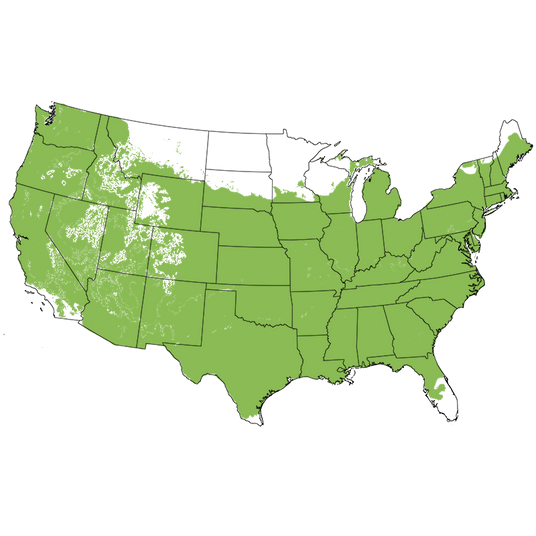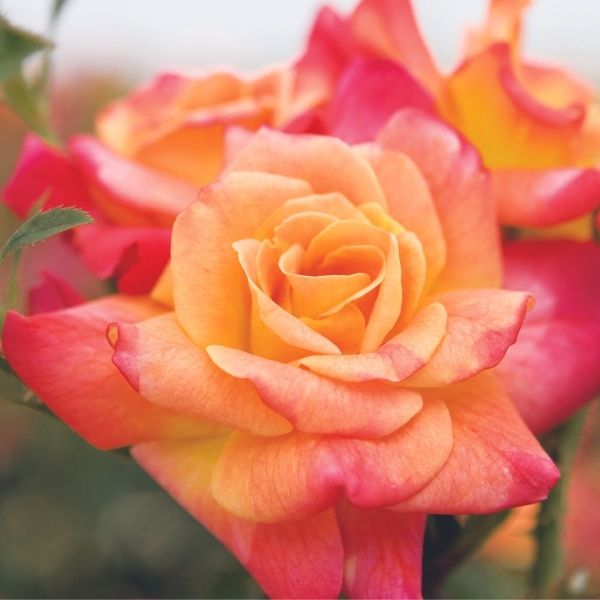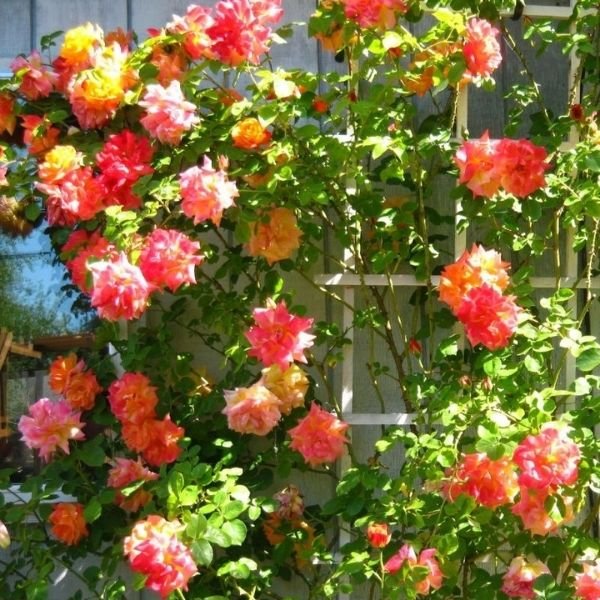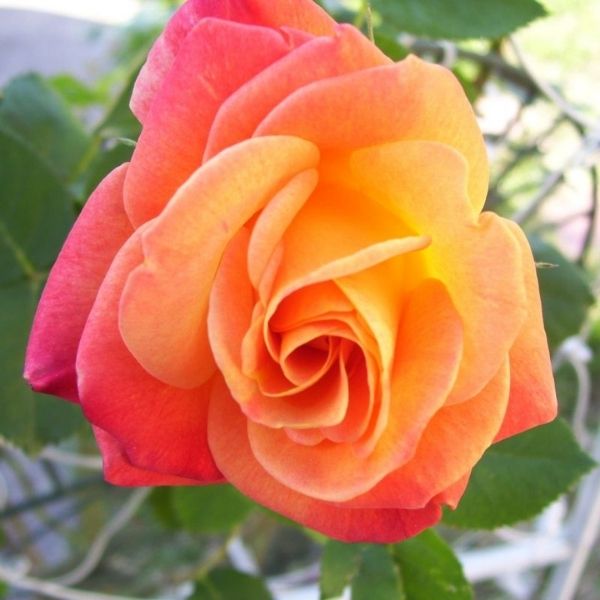Joseph's Coat Climbing Rose
Rosa 'Joseph's Coat'
Plant Sentry™
Plant Sentry™

Plant Sentry™ Protected
Your order is protected by our compliance system that:
- Prevents restricted plants from shipping to your state
- Ensures plants meet your state's agricultural requirements
- Protects gardens from invasive pests and diseases
Delivery and Shipping
Delivery and Shipping
Delivery and Shipping
Fast, Safe Plant Delivery
Ships in 3-4 business days • Tracking provided • Weather protected
| Under $50 | $9.99 |
| $50 - $99.99 | $14.99 |
| $100 - $149.99 | $16.99 |
| $150 - $198.99 | $24.99 |
| $199+ | FREE |
✓ Zone-specific timing • ✓ Professional packaging • ✓ Health guarantee
Understanding Plant Options
Nature Hills offers plants in two main formats:
- Container Plants: Grown in pots with soil, sized by container volume and plant age
- Bare Root Plants: Dormant plants without soil, sized by height measurements
Container Plant Sizes
Container sizes indicate plant age and growing capacity rather than liquid volume equivalents. Our containers follow industry-standard nursery "trade gallon" specifications, which differ from standard liquid gallon measurements.
Young Plants (6 months to 18 months old)
| Container Size | Actual Volume | Metric Equivalent |
|---|---|---|
| 2" x 2" x 3" | 0.18 - 0.21 dry quarts | 0.20 - 0.23 dry liters |
| 4" Container | 0.31 - 0.87 dry quarts | 0.35 - 0.96 dry liters |
| 4.5" Container | 0.65 dry quarts | 0.72 dry liters |
| 6" Container | 1.4 dry quarts | 1.59 dry liters |
| 1 Quart | 1 dry quart | 1.1 dry liters |
| 5.5" Container | 1.89 dry quarts | 2.08 dry liters |
Established Plants (18 months to 2.5 years old)
| Container Size | Actual Volume | Metric Equivalent |
|---|---|---|
| 2 Quart | 2 dry quarts | 2.2 dry liters |
| #1 Container | 2.26 - 3.73 dry quarts | 2.49 - 4.11 dry liters |
| 5" x 5" x 12" | 3.5 - 4.3 dry quarts | 3.85 - 4.74 dry liters |
Mature Plants (2-4 years old)
| Container Size | Actual Volume | Metric Equivalent |
|---|---|---|
| #2 Container | 1.19 - 1.76 dry gallons | 5.24 - 7.75 dry liters |
| #3 Container | 2.15 - 2.76 dry gallons | 8.14 - 12.16 dry liters |
Large Plants (3-5 years old)
| Container Size | Actual Volume | Metric Equivalent |
|---|---|---|
| #5 Container | 2.92 - 4.62 dry gallons | 12.86 - 20.35 dry liters |
| #6 Container | 5.25 - 6.01 dry gallons | 23.12 - 26.42 dry liters |
| #7 Container | 5.98 - 6.53 dry gallons | 26.34 - 28.76 dry liters |
Bare Root Plants
Bare root plants are sold by height from the root system to the top of the plant. Plants may exceed minimum height requirements.
Common Sizes:
- Trees: 1 foot, 2 feet, 3 feet, 4 feet, 5 feet, 6 feet
- Shrubs & Perennials: 1 foot, 18 inches, 2 feet
Important Notes
Container Volume Specifications
- Trade Gallon Standard: Our containers follow industry-standard "trade gallon" specifications established by the American National Standards Institute (ANSI Z60.1) for nursery stock
- Volume Variations: Actual soil volume may vary due to plant root systems and growing medium settlement
- Age Indicators: Container size primarily indicates plant age and maturity rather than liquid volume equivalents
Growing Conditions
- Plant size can vary based on variety and growing conditions
- Container size helps indicate plant maturity and establishment level
- Larger containers generally mean more established root systems and faster landscape establishment
Seasonal Availability
- Bare root plants are available seasonally when dormant
- Container plants are available throughout the growing season
- Specific varieties may have limited availability in certain sizes
Questions?
For questions about specific plant sizes or availability, please contact our plant experts who can help you choose the right size for your landscape needs.

Plant Sentry™ Protected
Your order is protected by our compliance system that:
- Prevents restricted plants from shipping to your state
- Ensures plants meet your state's agricultural requirements
- Protects gardens from invasive pests and diseases
Plant Profile & Growing Essentials
Cold hardy, Reblooming, Flowering, Fragrant, Attracts pollinators, Disease resistant, and Fast-growing
Specifications
Specifications
-
Botanical Name
-
Height
-
Width
-
Growing Zones
-
Sunlight
-
Growth RateModerate
-
Flower Color
-
Leaf Color
-
Pollinator FriendlyYes
-
FragrantYes
-
Bloom PeriodLate Spring, Early Summer, Late Summer
Planting & Care Instructions
Planting & Care Instructions
Fruity bi-color Joseph's Coat is a modern, Climbing Rose valued for its uniquely colorful blooms. Your Joseph's Coat (Rosa 'Joseph's Coat') is one of the most popular Climbing Roses available today. The blooms start as cheerful red buds, then soon bloom into a kaleidoscope of color! As the 3-4 inch blossoms develop, you'll be treated to a delightful blend of golden oranges and buttery yellows, intermixed with flame-touched edges.
It's a multi-toned symphony of floral brilliance that is sure to leave you and your neighbors dazzled! Joseph's Coat grows in an upright nature, its glossy, dark green leaves nicely filling out its form. The canes are flexible enough to make training them relatively easy and pruning is likewise a simple matter. You'll snip bountiful bouquets of bi-color blossoms and still have more to feed the many pollinators that this Rose attracts!
Pest and disease-resistant, your Joseph's Coat is also tolerant of a variety of conditions. Joseph's Coat Climbing Rose is a repeat bloomer, gracing your yard with lightly fragrant, semi-double flowers from late spring up until early fall. The blooms even do well as cut flowers, so you can bring a few inside as well! Hardy throughout steamy and humid USDA growing zones 6 through 10, and grows fast to an 8 to 12-foot tall dense clump of foliage that grows 6 through 8 feet in width.
Planting and Application:
Imagine one of these covering a fence in your yard or gracing a decorative arbor. With a little determination, you can even train your Joseph's Coat into a small shrub to accent your perennial bed. Create a Rose-festooned arbor, or tall, skinny Rose pillar as an accent for a year-round structure! You can also include these on a fence line to hide an eyesore or become a vivid backdrop to your garden beds and borders!
Install a six-foot trellis around your pool and train Joseph's Coat Rose for fun, light-hearted "living wallpaper" and walls around "outdoor rooms"! Imagine the pretty privacy and screening! You'll have carved out a special place throughout your landscape! Even grown up on a trellis or trained up the sides of your porch, patio, deck, or gazebo, this Climbing Rose will provide shade and privacy! On apartment balconies, grow them in large containers to train up along a modular trellis system.
Tie this vigorous Climbing Rose to a sturdy trellis and fencing for an incredible privacy screen or garden decoration. Everyone wants a private pool deck, but nobody wants to sacrifice their spot in the sun! On steep slopes, use Climbing Roses as a gorgeous groundcover planting! Plant them six to eight feet apart on center, and spread the canes out in a fan shape to ramble and scramble down your hill.
- Unique Flower Color Combination - Rosy Pink, Apricot & Golden Orangey-Yellow
- Re-Blooming Climbing Rose
- Great Cut Flowers & Pollinator-Favorites
- Vigorous Grower With Big Sprays of Blossoms
- Vertical Color & Backdrops, Space-Saving Accents & Specimen
#ProPlantTips for Care:
Choose a sunny planting site that receives at least six hours of sunlight a day. Climbing Roses need good air circulation, sturdy support structures and well-drained soil. Don't forget the Nature Hills Root Booster, to give this fragrant Rose life-long support when used during planting. Provide a location with good air circulation and organically enriched well-drained soil. Fertilize regularly with a good quality slow-release Rose fertilizer.
How to Prune and Train Climbing Roses
Pruning should not be done during the first two to three years, since Climbing Roses need time to build flowering Rose canes. These structural canes will grow thicker for several years before it is time to replace them.
Spring Pruning and Structural Rejuvenation
Remember that spring pruning is most limited to removing broken branches, and dead tips or correcting the structure of the Climbing Roses. If you remove long canes and side branching you will be removing the first set of June flowers.
- Prune Roses in early spring just as you see new buds beginning to swell.
- Remove any dead, diseased, or damaged branches.
- Identify several new, younger, more vigorous canes to become the new structural foundation of your beautiful Climbing Rose.
- Remove the fattest, oldest canes out at the soil level, if possible and right after the first set of flowers finishes. Those canes will be replaced with new shoots that develop from the base. As these new, rapidly produced shoots elongate, you will want to direct, train, and tie them into the place you would like them to develop.
Summer Maintenance and Pruning
Horizontal branches produce the most flowers. Prune these secondary canes after flowering, because Climbing Roses bloom on last year's canes (old wood).
- Cut your secondary canes down to 6 - 8 inches above a bud after the first flush of flowers has finished.
- Trim the secondary canes back at 90 to 45-degree angles.
- Keep your structural support canes in place.
In colder regions it may be more difficult to maintain Climbing Roses, so choosing your planting site is important.
Winter protection is best for Roses grown in zones 7 and colder. Mulch is your best, more natural way to overwinter Roses by mounding the dormant canes in late fall. Don't fall prune, rather instead wait until spring. Find all you need about pruning Roses here, and about winterizing your Roses Here and un-wintering Roses in Spring in our #ProPlantTips Garden Blog!
- Full Sun Lover
- Moist Enriched Well-Drained Soil
- Regular Fertility & Moderate Moisture Needs
- Prune Early Spring & Deadhead For New Blooms
- Mulch Very Well
- Disease & Pest Resistant
If you're looking for something unique in a small climber, then Joseph's Coat Rose is for you! Hardy and easy to train, plus uniquely colorful blooms that put on a show all summer long, Joseph's Coat Climbing Rose is a superb choice for your yard this year. Now available at NatureHills.com!
Rose Bush FAQs
Where Is The Best Place To Plant Climbing Rose?
Roses need a protected location and prefer full sun and favor the drying power of the morning sun and flower best in at least 6 hours of direct sunlight a day. Choose a location in good, enriched soil that drains well and has good air circulation.
What Is The Best Month to Plant Climbing Roses?
You can plant Roses any time if you are able to provide enough consistent moisture and attention. While there is not a specific month that is best, generally because it changes with temperatures, climate and growing zone. However, the easiest times of the year to get Rose bushes established in your landscape are in spring after the last frost date, and in fall about 4-6 weeks before the first frost.
Do Roses Come Back Every Year?
Climbing Roses are deciduous woody perennial shrubs and will return bigger and better each year.
How Do I Find Rose Bushes & Trees for Sale Near Me?
Make your life easier and your yard happier by shopping for Roses at NatureHills.com online nursery. You'll find a massive selection of Rose bushes for sale, including many lovely Tree-form varieties!
Choose the right shrub for your area by first finding your growing zone by entering your zip code in the field above the Plant Highlights section on our product pages. Narrow down your options by plant hardiness zone, sun availability, and size requirements.
Place your order, knowing it's backed by the Nature Hills Nursery product guarantee and protected by Plant Sentry™, which helps ensure regulated plant materials aren't sent to prohibited areas.
Expect to receive your plants at the appropriate planting time for your growing zone when temperatures are safest to ship through and into.













